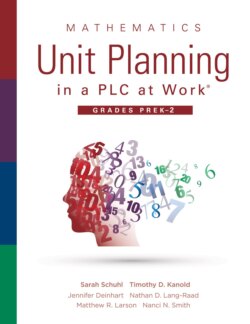Читать книгу Mathematics Unit Planning in a PLC at Work®, Grades PreK-2 - Timothy D. Kanold - Страница 9
На сайте Литреса книга снята с продажи.
ОглавлениеPART 1
Mathematics Unit Planning and Design Elements
Creating a guaranteed, viable curriculum is the number-one factor for increased levels of learning.
— Robert J. Marzano
PART 1
As your prekindergarten, kindergarten, first-, or second-grade team clarifies what students will learn in mathematics at each grade level, it brings a laser-like focus to the content and processes students must learn in each unit throughout the year. Your team clarifies the depth of learning required for students to become proficient with the mathematics standards, and you and your team members build a shared understanding of the content students must learn in each unit of study. Together, you determine the mathematics your team must teach and assess throughout each unit.
The action of intentional planning as a team for student learning of mathematics on a unit-by-unit basis develops your individual and team collective teacher efficacy.
Working together with your colleagues as a collaborative mathematics team, you erase the inequities in student learning expectations that otherwise could exist across a grade level or course. Together, you and your team determine what students must know and be able to do. Then, your team does the work to ensure every student learns through the agreed-on, high-quality instruction, common assessments, and formative assessment processes. Your team recognizes the many challenges inherent to students learning robust mathematics standards and takes collective responsibility to close gaps and extend learning as needed.
To erase inequities and ensure grade-level learning of mathematics for each student, your primary-level team begins with an agreed-on guaranteed and viable curriculum for mathematics. Your team works to ensure students learn identified essential mathematics standards within the school year.
On a unit-by-unit basis, your team builds a shared understanding of the essential mathematics standards students must learn. PLC experts and coauthors Richard DuFour, Rebecca DuFour, Robert Eaker, Thomas W. Many, and Mike Mattos (2016) explain that your shared understanding will:
• Promote clarity among your colleagues about what students must learn
• Ensure consistent curricular priorities among colleagues
• Help develop the common pacing required for effective common assessments
• Ensure the curriculum is viable (that you can teach in the allotted time)
• Create ownership among all teachers required to teach the intended curriculum
It might be surprising, but in a PLC at Work, teacher teams build mathematics units from the standards, not from the chapters in a textbook. Too often, textbooks include more learning than your state or province may require, or the textbooks may be missing content that you need to supplement to better match the standards and local curriculum expectations. Thus, your team starts with making sense of the standards students must learn in each unit of study, and then utilizes the most effective resources for teaching and learning.
Part 1 consists of two chapters. Chapter 1 (page 9) describes the mathematics content and skills students must learn in grades preK–2. Your team’s work begins by understanding what mathematics students must learn in each of the primary grades, preK, K, 1, and 2. Chapter 2 (page 15) provides protocols and tools your grade-level collaborative team can use to plan for the student learning each mathematics unit requires. Together, your team’s understanding of the mathematics content students must learn and your framework for units allows for a backward-design approach to ensuring every student learns mathematics.
